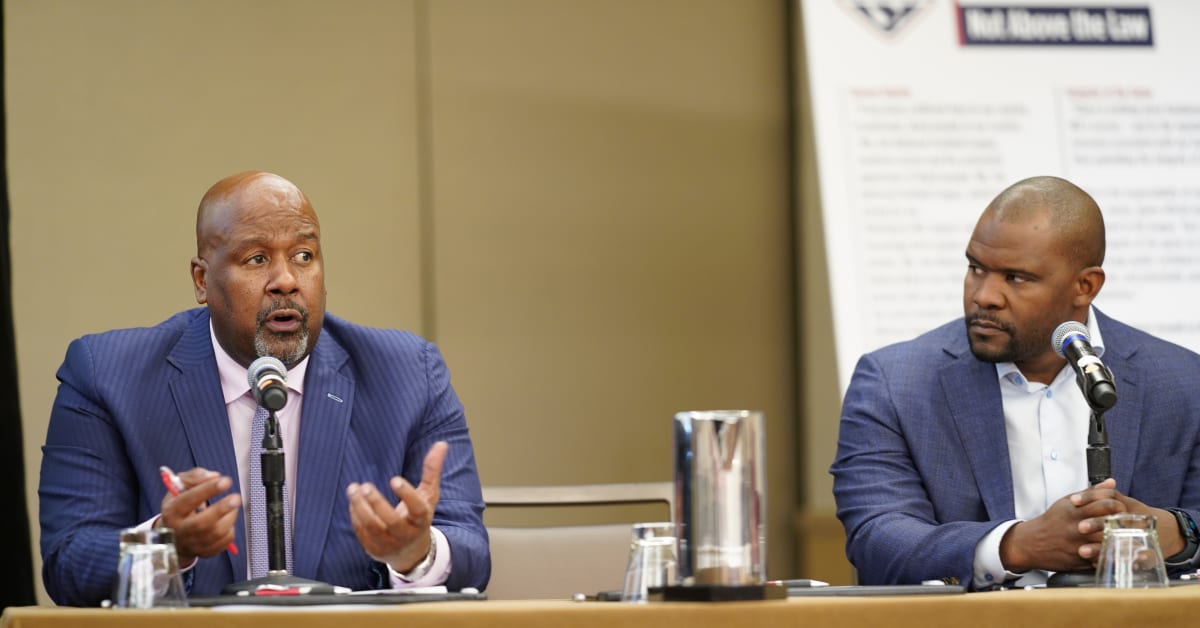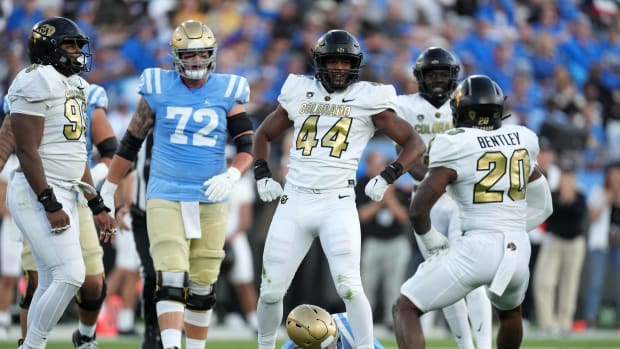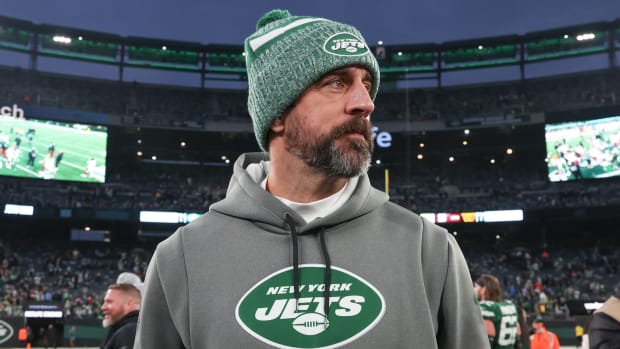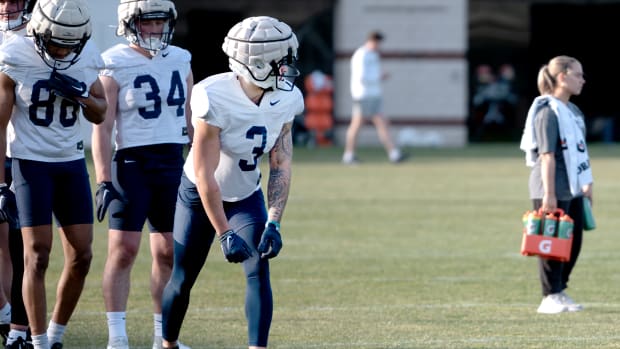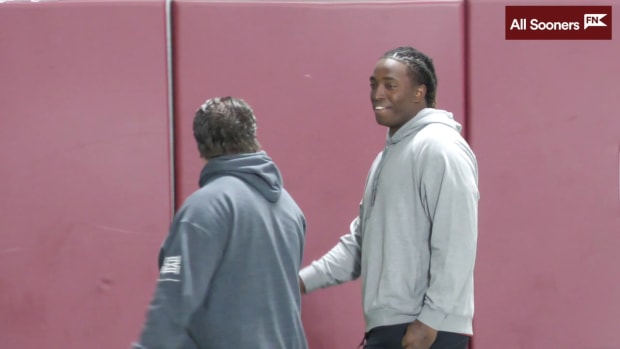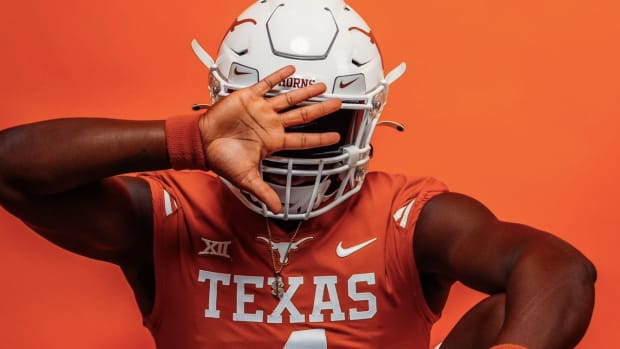Summit Shows Progress, and Work Yet to Be Done, Around Diverse Hiring in Football

NCMFC president Locksley (left) and Flores were part of the summit in New York City.
Courtesy of Jay McClinton
NEW YORK — The National Coalition of Minority Football Coaches is no longer new. The brainchild of Maryland coach Mike Locksley and former college teammate turned attorney Thomas Bundy, the organization now has a foundation and nearly two years of operation under its belt.
When Steelers senior defensive assistant Brian Flores filed a lawsuit against the NFL and three teams alleging discrimination in hiring practices, the NCMFC saw an opportunity. It assembled a group of leaders to bring different perspectives to the table for a summit on how to tackle the issue of systemic racism in all levels of football.
The four-hour roundtable discussion held Wednesday included civil rights attorneys, college professors, influential Black media members and career football people such as NFLPA executive director DeMaurice Smith. Flores and his legal team attended while his new boss, Steelers coach Mike Tomlin (an early NCMFC board member) participated via Zoom.
“We’re a solution-based organization,” says Locksley, who also serves as the NCMFC’s president.
The NCMFC was born during the COVID-19 pandemic lockdown as Locksley reflected on what type of legacy he would leave behind. He described himself as being on the back nine of his career with a “give-a-crap” gauge on empty in terms of allowing hiring discrimination to continue to go unchecked.
The group later hired former civil rights attorney Raj Kudchadkar as executive director who, along with Bundy (now the NCMFC’s general counsel) and other staff members, handles the day-to-day while Locksley is in season. The Terps coach still quips about how little sleep he gets thanks to late-night Zooms but is thankful for the support he receives from Maryland athletic director Damon Evans and school president Darryll Pines, both of whom are Black.
Locksley has seen the progress in diverse hiring move backward from 18 Black coaches out of 131 FBS jobs during his time as coach at New Mexico to the 14 who will roam sidelines this fall. The NFL has five nonwhite head coaches, including two who are Black (Tomlin and Houston’s Lovie Smith) and Miami’s Mike McDaniel, who identifies as multiracial.
No splashy press conferences or official proposals came out of the summit. Discussions hit on subjects such as the Rooney Rule (the Coalition does not have a formal position on it, but Locksley doesn’t believe it’s necessary at the collegiate level), Flores’s lawsuit and how football’s hiring disparities are somewhat like other facets of American life.
“One of the things we always say is, ‘We don’t want to just complain about the issue; we want to be proactive and we want to be a driving force,’” Kudchadkar says. “So, the first thing we need to do is look at our notes and what are things that we can move on here. We need to digest this. There’s a lot of great information, but I’m the first person to tell people I’m a civil rights attorney; I’m not a coach. There’s a lot I learned today; there’s a lot our staff learned today.”
Bundy says football is “multilayered,” especially at the collegiate level. The NFL may have 32 different owners with 32 different ideas, but at least the whole process is mostly self-contained within the structure of the league. Collegiate hires can have Wild West–type sagas accompanying each one of them—so many different stakeholders jump into the mix, inside and outside the athletic departments.
“What you have is the fluidity of people, whether it be at the collegiate level or NFL, to be able to point to somebody else,” Bundy says. “It’s always a moving target. So one of our missions is to corral all these issues and get to them so they’re not so squishy. There’s a way to do it. It’s going to take a lot of hard work. Sometimes it might be a little controversial, and we’re not always going to be looked upon as people’s best friends, but we’re only going to act in the name of justice, equality and equity.”
The state of football coaching searches is, as Locksley succinctly puts it, less of a hiring process and more of an election. Similar to how political parties will typically provide a group of primary candidates for voters to choose from for general elections, hot coaching candidates are surfaced by agents, search firms and the media, leading schools to make decisions that, as Kudchadkar says, are “of the moment.” Those decisions are typically skewed by nebulous things such as “fit,” which has a different definition for various decision-makers in the process. While this style of hiring can shut out minorities as the goalposts continue to move seemingly on a whim, Locksley acknowledges he did benefit from it as someone who had never stepped foot in New Mexico before he took the Lobos’ job.
Locksley said the coalition had dialogue with about 90% of the organizations that had job openings in the last cycle. They send a certified letter to the college presidents and athletic directors, or NFL execs, for every collegiate and NFL job that opens up, letting them know the NCMFC is there to assist and locate qualified minority candidates. It’s gotten to the point where most schools reach out to the NCMFC directly.
“We’re not here to tell people who to hire; we’re not here telling the NFL you have to hire a minority,” Locksley says. “There are so many coaches that are prepared with the tools necessary to lead programs, but we just want you to put them on the dance floor and give them a real opportunity.”
They also try to gauge the pulse on who is actually doing the hiring and what needs the schools are trying to meet. In this way, the coalition operates almost as a search firm, recommending candidates they believe are qualified and supporting those suggestions with detailed profiles using nearly 200 metrics provided by SportSource Analytics—a data company that provides tools for leading coaching agencies, as well as the College Football Playoff selection committee.
“That’s why it’s important to have a board that’s committed and connected,” Bundy says. “They’re great football people and they’re committed to making a difference. They’re at a lot of crossroads in their career where what matters the most is not more money and not more championships but making a meaningful legacy for themselves.”
The NCMFC has an all-star list of current and former football executives from college and the NFL on its board of directors, including Hall of Famers Ozzie Newsome and Bill Polian; former longtime AD Debbie Yow; Missouri athletic director Desiree Reed-Francois; Commanders senior VP Doug Williams (the first Black QB to win a Super Bowl); Tomlin; and Locksley’s former boss at Alabama, Nick Saban.
This network is at the root of Locksley’s career renaissance and how the Coalition is attempting to push for change. After interviewing for jobs at West Virginia, Iowa State and even the Clemson job that eventually went to Dabo Swinney following his interim stint, Locksley finally received his first head coaching gig at New Mexico in 2009. After a failed stint at New Mexico, Locksley returned to Maryland, where he had previously been an assistant while Yow was AD in the late 1990s. He coached under Randy Edsall until Edsall got fired and, at the advice of Yow, he rebranded. He turned down offers to be a coordinator, instead opting to become an off-field analyst at Alabama. He climbed to co-offensive coordinator for the Tide in a matter of months, and then to solo coordinator during Alabama’s 2018 title game run before getting his “dream job” at Maryland. In doing so, Locksley became a rarity: a Black coach who got a second chance.
Now the coalition leverages the power of the network for information-gathering as well as how they look to pay things forward with Black coaches searching for their first or next opportunity. Yow, Reed-Francois and 11 other leading athletic directors formed one-on-one mentor-mentee relationships with Black coaches through the organization’s yearlong Coalition Academy program. Of the 13 coaches involved, Marcus Freeman (Notre Dame) and Tony Elliott (Virginia) became first-time head coaches, while Jay Norvell went from Nevada to Colorado State. They represent three of four Black head coaches hired in the 2021 coaching cycle.
The Academy included promising up-and-coming minority coaches such as Miami offensive coordinator Josh Gattis, Eagles QB coach Brian Johnson, Tennessee running backs coach Jerry Mack, FAMU coach Willie Simmons, Chargers wide receivers coach Chris Beatty, Illinois defensive coordinator Ryan Walters, Alabama defensive backs coach Travaris Robinson and UNLV’s Marcus Arroyo. In addition, Texans QB coach Pep Hamilton (a household name in the industry still yet to get his first NFL or college head coaching job) and Temple chief of staff Everett Withers (a former head coach at North Carolina, James Madison and Texas State) also participated.
They will “graduate” soon, making way for another class of coaches, while the organization is looking into how to launch a similar program in the NFL. Their program is not the first of its kind, but it does try to differentiate itself by being more of a yearlong process with the hope it will scale up to include more coaches and ADs in the future.
“There’s a lot to be learned in terms of, for example, media savvy, social and emotional intelligence. How do you work with boosters? How do you manage your team? All these other things outside of the X’s and O’s,” Kudchadkar says. “So looking at these academies that already existed and it’s, ‘Hey, we’re gonna bring in these minority coaches for an intensive three days, four days and just throw all this information at them.’ We said, ‘You know what, our academy is going to focus primarily on mentorship and networking.’”
What makes football so much like any other industry is the reliance on relationships. You’d be hard-pressed to find someone in major college football who is more than two degrees of separation away from anyone else. But expanding and further overlapping networks is one way to continue to attack the issue, leading to the next phase of the NCMFC’s existence going into its third hiring cycle this fall.
“There’s what we call a ‘Small A’ advocacy and a ‘Big A’ advocacy,” Kudchadkar says. “Small A is where we advocate for our individual coaches. Coach X is like, ‘I need support; I need training,’ and we’re supporting that. We have our mantras—prepare, promote, produce—so we’re working with individual coaches. But then we have the Big A that’s systemic advocacy. That’s what we were talking about here. How do we change the system?”
The coalition’s membership is now around 1,300 dues-paying members made up almost equally of college and high school coaches, with its sights set on figuring out how to interface with the NFL. As for the college game, the goal is to continually leverage their network to surface qualified minority candidates and build ways to hold programs accountable.
“When you look at some of the universities … everything is public,” Bundy says. “[Many] are public institutions. You have certain obligations as a public institution; you can’t just wink and nod, you can’t be performative in your actions. You have obligations. Now you haven’t been held to those, but there’s a new group in town that’s going to hold people to those obligations.”
